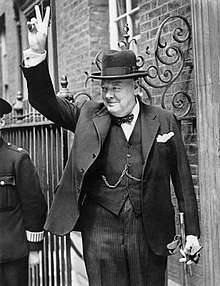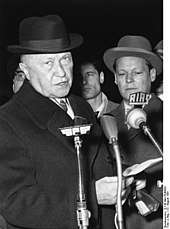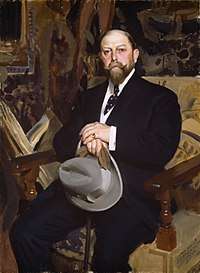Homburg hat



A homburg is a semi-formal hat of stiff felt, characterized by a single dent running down the center of the crown (called a "gutter crown"), a grosgrain hatband, a stiff brim shaped in a "kettle curl", and a bound edge brim trim. It is usually offered in dark colours, although lighter grey variations exist. The original homburg was of slightly more generous proportions than often seen in 21st-century versions.[1]
Although the homburg is considered a more formal hat, it is not an equivalent alternative to the top hat for formal attire, but more usually worn with clothing appropriate for semi-formal attire or at least informal attire (not to be confused with casual attire).[2] Considered an equivalent semi-formal hat, though, is the boater.
The name originates from Bad Homburg in Hesse, Germany, from where it was popularised in the late 19th century.
Use
The Homburg was popularised in the 1890s by Edward VII after he visited Bad Homburg in Hesse, Germany, and brought back a hat of this style.[3] He was flattered when his hat style was mimicked, and at times he insisted on being copied.[4]
Anthony Eden made the dark homburg so fashionable in the 1930s that it became known as "the Eden" on Savile Row.[5] At his 1953 inauguration, Dwight D. Eisenhower broke with tradition by wearing a black homburg instead of a top hat. He also wore a homburg at his second inauguration, a hat that took three months to craft and was dubbed the "international homburg" by hatters since workers from ten countries participated in its making.[6]
Like other formal Western male headgear, the homburg ceased to be as common in the 21st century as it once was. Al Pacino gained some renewed fame for the homburg by wearing one in the film The Godfather, for which reason the hat is sometimes called a "Godfather".[7] Some Orthodox Jewish, usually Misnagdish, rabbis wear black homburgs, though this practice is also in decline. It is considered somewhat more traditional and distinguished than the black fedora commonly worn by Orthodox Jews. Former Chief Rabbi of Israel Yona Metzger is typically pictured wearing a homburg hat.
See also
References
- ↑ Kilgour, Ruth Edwards (1958). A Pageant of Hats Ancient and Modern. R. M. McBride Company.
- ↑ "Hat Museum Bad Homburg". Retrieved 2012-05-18.
- ↑ Chico, Beverly (3 October 2013). Hats and Headwear around the World: A Cultural Encyclopedia. ABC-CLIO. p. 245. ISBN 978-1-61069-063-8.
- ↑ Donaldson, Frances (1974). Edward VIII. Weidenfeld & Nicolson, p. 42.
- ↑ Graves, Robert; Hodge, Alan (1994). The Long Week End: A Social History of Great Britain, 1918-1939. Norton. p. 364. ISBN 978-0-393-31136-5.
- ↑ Wilcox, R. Turner (2013) [1959]. The Mode in Hats and Headdress: A Historical Survey with 198 Plates. Dover Publications. p. 333. ISBN 978-0-486-31830-1.
- ↑ Kramer, Johnny (29 August 2008). "The Courage to Wear Hats". LewRockwell.com. Retrieved 2014-03-20.
External links
| Wikimedia Commons has media related to Category:Homburg hats. |
- "Felt dress hats" at Hat History
- "Homburg Hat – Past, Present and Future" at Gentleman's Gazette